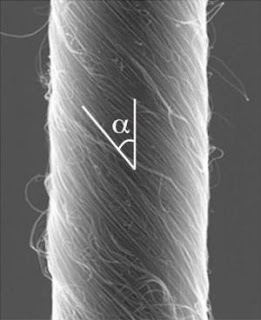 |
| CNT yarns (sciencedaily) |
These muscles have a diameter ten thousand times smaller than a human hair, then spun into yarn made helix. So that the yarns are very flexible, which means that they have left and right hand versions (such as our hands), which is controlled by an electric voltage.
As a result, these the yarns can paddle 2,000 times faster and rotation of turning when the voltage change. The demonstrated rotation of 250 per millimeter of muscle length is over a thousand times That of previous artificial muscles, the which are based on ferroelectrics, shape memory alloys, or conducting organic polymers. This muscle is fairly inexpensive, can be made very long to millimeter size, the source voltage used is also quite small. So it can save costs. The nanotube torsional motors consist of a yarn electrode and a counter-electrode, the which are immersed in an ionically conducting liquid.
These yarns, work based on the characteristic of supercapasitor. Ions migrate into the yarns, to achieve balance electrostatically. Then the ions are injected into the carbon nanotube electrically. A porous form of this yarns cause yarns volume increases as the ions enter, shrink in length, and then rotate.
"The discovery, characterization, and understanding of these high performance motors torsional shows the power of international Collaborations," said Ray H. Baughman, a corresponding author of the author of the Science article and Robert A. Welch Professor of Chemistry and director of The University of Texas at Dallas Alan G. MacDiarmid NanoTech Institute. "Researchers from four universities in three different CONTINENTS That were the resource persons born in eight different countries made critically Important contributions."
Post a Comment